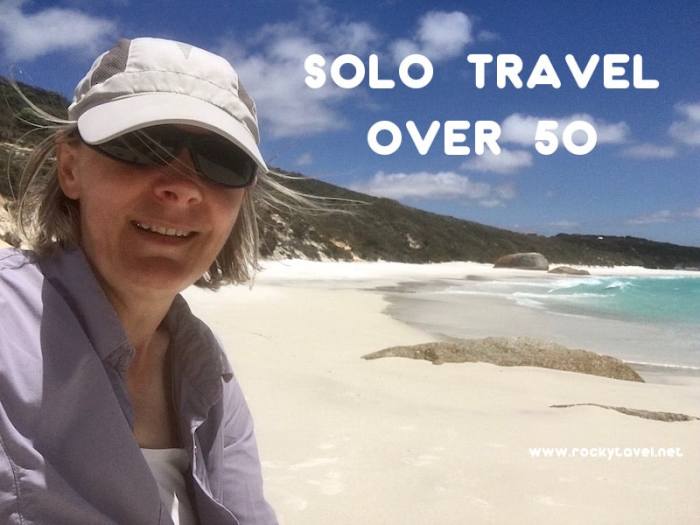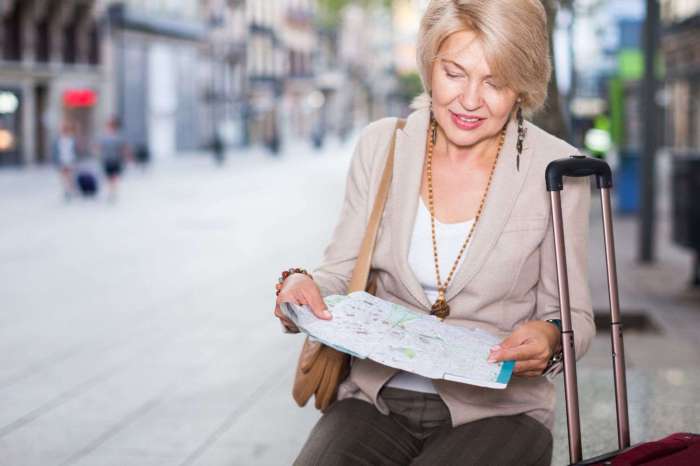Solo Travel Over 50: Embarking on a solo adventure after 50 offers unparalleled freedom and self-discovery, but requires careful planning. This isn’t just about ticking off bucket-list destinations; it’s about navigating potential challenges – from health concerns to safety in unfamiliar territories – and maximizing the rewards of independent exploration. This guide equips seasoned travelers with the knowledge and strategies to make their solo journey both fulfilling and secure.
From pre-trip health checks and meticulous itinerary design to budgeting effectively and mitigating loneliness, we delve into the practical and emotional aspects of solo travel for the over-50 demographic. We’ll explore diverse accommodation options, highlight essential tech tools, and offer advice on choosing destinations and activities that perfectly align with individual preferences and physical capabilities. The goal? To empower you to confidently embrace the transformative power of solo travel in your later years.
Safety and Security Concerns for Solo Travelers Over 50: Solo Travel Over 50
Solo travel after 50 offers unparalleled freedom and self-discovery, but it’s crucial to acknowledge and mitigate potential safety risks. While the vast majority of solo travel experiences are positive, proactive planning and awareness are key to ensuring a safe and enjoyable trip. This section addresses common concerns and provides practical strategies for mitigating them.
Safety Risks for Solo Travelers Over 50 by Location Type
Understanding the specific safety challenges associated with different travel environments is paramount. The risks vary considerably depending on whether you’re exploring bustling city centers, tranquil rural areas, or navigating the complexities of international travel. The following table categorizes these risks:
| Risk Category | Urban Environments | Rural Environments | International Travel |
|---|---|---|---|
| Petty Theft | Pickpocketing, bag snatching in crowded areas. | Vehicle break-ins, theft from unattended campsites. | Increased risk in tourist hotspots, scams targeting travelers. |
| Violent Crime | Mugging, assault in poorly lit or isolated areas. | Limited emergency services response times. | Higher incidence in some regions; potential for political instability. |
| Health Emergencies | Access to medical care generally readily available, but can be expensive. | Limited or distant access to medical facilities. | Language barriers, unfamiliar healthcare systems. |
| Accidents | Traffic accidents, falls, slips. | Hiking accidents, wildlife encounters. | Transportation accidents, unfamiliar road conditions. |
| Isolation | Feeling lost or overwhelmed in large cities. | Limited social interaction, difficulty getting help in emergencies. | Language barriers, cultural differences can lead to feelings of isolation. |
Mitigating Safety Risks: Pre-Trip Planning and On-the-Ground Precautions
Thorough pre-trip planning and sensible on-the-ground precautions are essential to minimize risks.
- Pre-Trip Planning: Research your destination thoroughly, including local laws, customs, and potential safety concerns. Share your itinerary with family or friends and register with your country’s embassy or consulate. Make copies of important documents (passport, insurance, etc.) and store them separately from the originals.
- On-the-Ground Precautions: Stay aware of your surroundings, avoid walking alone at night in unfamiliar areas, and use reputable transportation services. Keep valuables secure and avoid displaying expensive jewelry or electronics. Learn basic phrases in the local language to facilitate communication in emergencies.
- Emergency Contacts: Program emergency numbers for local police, ambulance, and your embassy into your phone. Consider purchasing a local SIM card for reliable communication.
- Health Considerations: Consult your doctor about necessary vaccinations and medications. Pack a well-stocked first-aid kit and familiarize yourself with local healthcare providers.
- Accommodation: Choose reputable accommodations in safe and well-lit areas. Inform the hotel staff of your itinerary and expected return time.
Travel Insurance for Older Solo Travelers: Benefits and Drawbacks, Solo Travel Over 50
Travel insurance is a critical investment for solo travelers over 50, offering financial protection against unforeseen events. However, it’s essential to carefully consider the policy’s terms and conditions.
- Benefits: Comprehensive travel insurance can cover medical emergencies, trip cancellations, lost luggage, and other unforeseen circumstances. Policies specifically designed for older travelers often address age-related health concerns and offer higher coverage limits.
- Drawbacks: Premiums for older travelers can be significantly higher than for younger individuals. Some policies may have exclusions or limitations related to pre-existing medical conditions. It’s crucial to carefully review the policy document before purchasing to ensure it meets your specific needs.
- Policy Considerations: Look for policies that offer comprehensive medical coverage, including emergency medical evacuation. Consider adding coverage for trip interruptions, lost luggage, and personal liability.
Budgeting and Financial Management

Planning a solo trip over 50 requires meticulous budgeting to ensure a comfortable and financially responsible journey. This involves a comprehensive assessment of potential expenses, strategic financial planning, and informed decision-making regarding payment methods. Failing to account for all potential costs can lead to unexpected financial strain, jeopardizing the enjoyment of the trip. Therefore, a well-structured budget is crucial for a successful and stress-free solo adventure.Effective budgeting begins with a realistic assessment of anticipated expenses.
This includes flights, accommodation, daily sustenance, planned activities, and a contingency fund for unexpected events. It’s advisable to create a detailed spreadsheet or utilize budgeting apps to track spending throughout the planning and travel phases. This allows for proactive adjustments and prevents overspending. For example, a two-week trip to Europe might require a budget encompassing round-trip airfare (approximately $1,000-$2,000 depending on the origin and destination), accommodation ($70-$150 per night depending on location and preferences), daily food costs ($50-$100), activities and entrance fees ($200-$500), and a minimum emergency fund of $500.
These figures are estimates and will vary significantly based on individual travel styles and choices.
International Payment Methods
Choosing the right payment method for international travel significantly impacts both convenience and cost. Credit cards offer broad acceptance, purchase protection, and fraud liability coverage, but may incur foreign transaction fees (typically 1-3%). Debit cards offer similar convenience but may have daily withdrawal limits and higher ATM fees abroad. Prepaid travel cards provide a fixed budget and may offer better exchange rates than credit cards, but have limitations on loading funds and may not be widely accepted everywhere.
Carrying cash provides flexibility but poses security risks. The optimal strategy often involves a combination of methods—a credit card for major purchases, a debit card for ATM withdrawals, and a small amount of local currency for smaller transactions. For instance, a traveler might rely on a credit card for flights and hotels, a debit card for accessing funds at ATMs, and a modest amount of local cash for daily expenses like food and transportation.
Resources for Affordable Travel Deals
Numerous resources cater specifically to finding cost-effective travel options for solo travelers. Websites such as Skyscanner, Google Flights, and Kayak provide flight comparison tools, enabling travelers to identify the most economical airfares. Booking platforms like Booking.com, Expedia, and Airbnb offer a wide range of accommodation choices, from budget-friendly hostels to mid-range hotels and vacation rentals. Furthermore, travel deal websites such as Groupon and LivingSocial frequently feature discounts on tours, activities, and attractions.
Utilizing these resources effectively requires diligent research and flexible travel dates, as the best deals are often found by being adaptable and open to different options. For example, traveling during the shoulder seasons (spring and fall) can often yield significantly lower prices on flights and accommodations compared to peak travel times.
Social Interaction and Loneliness Mitigation

Solo travel, particularly for those over 50, presents unique opportunities for self-discovery but can also heighten the risk of loneliness. Combating this requires proactive strategies to foster social connections and build a sense of community, even while traveling independently. Successfully navigating this aspect of solo travel can significantly enhance the overall experience, transforming potential isolation into enriching encounters.The key to mitigating loneliness lies in embracing opportunities for interaction, both with fellow travelers and locals.
This involves a conscious effort to step outside one’s comfort zone and engage with the world around them. Fortunately, many avenues exist to facilitate these connections, offering diverse ways to build camaraderie and lasting memories.
Strategies for Combating Loneliness
Effectively combating loneliness while traveling solo requires a multi-faceted approach. It involves a proactive mindset and a willingness to participate in activities that encourage social interaction. This can range from simple conversations to joining organized group excursions. For example, striking up a conversation with a fellow traveler during a sightseeing tour or sharing a meal with locals at a restaurant can lead to unexpected friendships and a deeper understanding of the culture.
The act of engaging in conversation itself can significantly improve mood and reduce feelings of isolation. Regularly scheduling time for social interaction, even if it’s just a coffee with a fellow traveler, can make a considerable difference.
Opportunities for Meeting Other Travelers and Locals
Numerous opportunities exist for connecting with others during solo travel. Staying in hostels, though less common for the over-50 demographic, often fosters a naturally social environment. Alternatively, boutique hotels and guesthouses can offer more intimate settings conducive to conversation with fellow guests. Participating in cooking classes, walking tours, or wine tastings provides structured environments where interactions are naturally facilitated.
Utilizing social media groups dedicated to specific destinations or travel styles can connect individuals with shared interests before and during their trips. Even simply engaging in conversations with locals at cafes, markets, or local events can lead to unexpected and enriching interactions. A smile and a simple “hello” can often open doors to engaging conversations and friendships.
Benefits and Drawbacks of Joining Organized Tours or Group Activities
Organized tours and group activities present a double-edged sword for solo travelers. On the one hand, they offer pre-planned itineraries, built-in social interaction, and the comfort of traveling with a group. This can be particularly beneficial for those who feel more secure in a group setting or who prefer a structured travel experience. Examples include guided walking tours, cooking classes, or multi-day excursions that cater specifically to solo travelers.
These structured environments often lead to spontaneous connections with other participants. However, joining organized tours can also limit spontaneity and independence. The pre-set itineraries may not always align with individual preferences, and the group dynamic might not always be a perfect fit. The cost can also be a significant factor, often exceeding the cost of independent travel.
Therefore, carefully weighing the benefits and drawbacks based on personal travel style and preferences is crucial.
Accommodation Options for Solo Travelers
Choosing the right accommodation is paramount for a safe and enjoyable solo trip, especially for travelers over 50. The ideal option balances comfort, security, and budget, varying greatly depending on individual preferences and the nature of the trip. This section compares and contrasts various accommodation types, highlighting their suitability for mature solo adventurers.
Hotel Accommodations
Hotels offer a range of options, from budget-friendly chains to luxurious boutique establishments. For solo travelers over 50, the advantages include readily available amenities such as room service, reliable security, and often, a central location. Disadvantages can include higher costs compared to other options, and a potentially impersonal atmosphere. Many hotels offer single occupancy rates, which can be cost-effective compared to double rooms.
Security features such as keycard access and 24-hour reception are crucial considerations for solo travelers. The level of service and amenities will influence the overall experience and cost. For example, a higher-end hotel may offer concierge services, which could be particularly beneficial for a solo traveler needing assistance with planning activities.
Hostel Accommodations
Hostels, traditionally associated with budget backpacking, are increasingly offering private rooms, catering to a wider demographic, including older solo travelers. The advantages are the lower cost and opportunities for social interaction. However, the shared facilities and potentially noisy environment may not be ideal for everyone, especially those prioritizing quiet and privacy. While some hostels are specifically geared towards older travelers and offer quieter, more private options, it’s crucial to carefully research the hostel’s atmosphere and reviews before booking.
Private rooms offer a good balance between cost-effectiveness and privacy.
Guesthouse Accommodations
Guesthouses provide a more intimate and personalized experience compared to hotels. They often offer a home-like atmosphere, sometimes with the inclusion of breakfast. This can be appealing to solo travelers seeking a less impersonal experience and potentially a more local perspective. However, guesthouses might lack the same level of security features as hotels and may be less centrally located.
The charm and local interaction are often their greatest draw, but travelers should ensure they verify safety features and location in advance. Booking through reputable platforms with reviews can mitigate some of these concerns.
Airbnb Accommodations
Airbnb offers a wide variety of options, from private rooms in shared houses to entire apartments or houses. This flexibility allows solo travelers to tailor their accommodation to their specific needs and budget. The advantages include potential cost savings, greater privacy, and the opportunity to experience a more local lifestyle. However, safety and security can be a greater concern with Airbnb than with hotels, as it involves interacting directly with individual hosts.
Thorough research of reviews and host profiles, and paying close attention to safety features like locks and security systems are critical. Consider choosing listings with multiple positive reviews and detailed descriptions.
Essential Features Checklist for Solo Travelers Over 50
Before booking accommodation, consider these essential features:
- Location: Proximity to transportation, attractions, and safe areas.
- Security: Keycard access, 24-hour reception (for hotels), well-lit areas, secure locks (for Airbnb).
- Amenities: Wi-Fi, comfortable bed, ensuite bathroom, and any other personal preferences.
- Reviews: Check multiple review platforms for feedback on safety, cleanliness, and overall experience.
- Accessibility: Consider accessibility features if needed, such as elevators and ramps.
- Cancellation Policy: Ensure a flexible cancellation policy in case of unforeseen circumstances.
Solo travel over 50 is a testament to the enduring spirit of adventure. While careful planning and preparation are crucial, the rewards – personal growth, newfound independence, and unforgettable experiences – far outweigh any perceived risks. By addressing safety concerns proactively, prioritizing health and wellness, and strategically managing logistics, individuals can unlock a world of possibilities, enriching their lives with journeys tailored to their unique desires and capabilities.
Embrace the journey, embrace the freedom, embrace the adventure.

